
“Can you please help me identify this black (sometimes white) feather looking wormy thing that moves when I uncover it?” asks this reader in her query. From the photos our reader sent us, there seems to be what looks like a gray feather, and a small, ovate organism-looking piece of matter that our reader states may be the same organism at a different stage of its life cycle.
Our reader clarifies that the feather-looking worm moves because it is exposed to light, and it was found hiding in a box of papers toward the bottom. She is based in Oregon and has been noticing these creatures around her house for two years. Her spouse thinks the creature is a feather, but she insists that it moves and is thus an organism. Now, upon looking up feather-looking worms/larvae, there are not that many results that pop up. We have furry caterpillars such as the woolly bear caterpillar and puss moth caterpillar, but both of these species have far longer ‘fur’ (which are actually bristles and are not safe to touch in the case of the puss moth caterpillar) and do not look like this organism at all. Furthermore, most other worm-like creatures that resemble feathers even somewhat happen to be marine organisms, and would not survive in the dry climate of a house, let alone a box of papers.
That being said, eventually we did stumble upon this fantastic video of a caterpillar mimicking a feather in order to escape the detection of birds that would prey on them. When we saw this, we thought that this might just be our guy. Oddly enough, no one seems to know what species of caterpillar this is. Now, whilst the feather in our reader’s photographs is gray, the caterpillar in the video is a bright white color, but then again, our reader did mention that she also found white feathers. That said, the feather in our reader’s photos is also very thin, and probably too thin to house the body of a caterpillar. In the video, we see a profile shot of the caterpillar which clearly shows its two rows of feet and bright green body, which should also be visible to our reader. We urge her to try to see the feather from the side, and see if it looks at all like the caterpillar in the video linked above, and furthermore if it moves in a similar fashion too. That said, we doubt that this is the caterpillar from the video.
When it comes to the other, small organism pictured below, we also cannot say what this might be. It looks like it might be the pupa of some creature, in which case our reader may be correct in assuming that this is the same species but at a different stage of its life cycle. On the other hand, it could very well be something else. Its lack of distinct features makes it difficult to say anything for certain; to the naked eye it looks merely like a pebble. What our reader could do is put this organism in a sealed container with some air holes and organic material for food (such as leaf litter) and wait to see what it grows into. If it does mature into something, our reader is more than welcome to send us more pictures or provide an update in the comments section below.
Alternatively, our reader’s spouse may be correct on this one; this might just be a feather. What our reader can do to check if this organism truly moves on its own is put it inside a big box and inspect it to see if it moves. The thing is, a feather –as light as they are– is bound to move if our reader is consistently disturbing the location in which it was found; they will move with the slightest of drafts or motions. Perhaps our reader’s spouse has just been leaving feathers around the home for two years to scare our reader, or perhaps this really is some unknown organism and our reader is the first one to discover it. Either way, we recommend taking precautions if and when handling the feather in the case that it is an organism, as the feathery strands may be bristles, which are often toxic on worms and larvae and which can cause allergic reactions.
To conclude, the feather-looking “wormy thing” moving in our reader’s apartment could be a number of things; it could be a caterpillar disguising itself as a feather, it could be a new organism that our reader had the fortune to discover, or it could simply just be a feather. If any of our other readers have any ideas as to the identity of this feather, or the identity of the caterpillar in the video linked above, feel free to share your input in the comments section below.
All About Worms is always free, always reader-supported. Your tips via CashApp, Venmo, or Paypal are appreciated! Receipts will come from ISIPP Publishing.
You might also find these guys interesting!









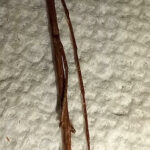

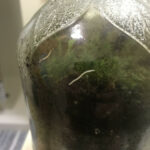
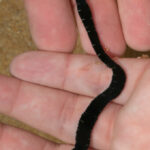
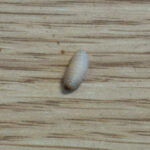
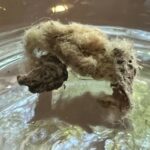
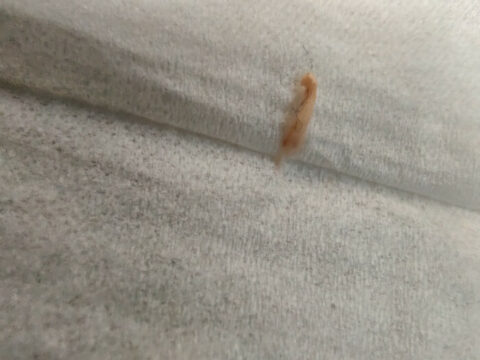
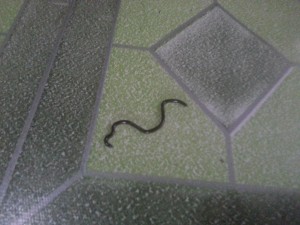
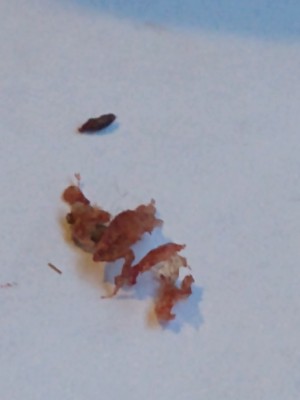



I have these feathers too. Found one yesterday with 5-6 black “feather branches” all joined at an ochre yellow center. I started having same parasitic symptoms described here last august… first my left thigh… then right. Then left arm. Last my right arm. It gets better but never goes away, then worsens. My hair fell out for about 2 weeks but stopped falling out and seems normal enough but I find the long “worm strands” imitating my hair and measuring up to 14” long.
I have the same featered worm in my house. It was white and the younger worms had no feathers on them.The second time I saw them on the back of the couch, lots of them. I went to get the vacuum, and by the time I came back they were gone. I need to find them before they turn in to something else. I really dont want to meet the bug that they really are. I cant find anything on them. If anybody knows what the adult and the eggs look like, please let me know.
I have been plagued by an unknown, unidentifiable skin condition for 8yrs. I am educated w/ 20+yrs working experience between nursing and pharmacy. I have seen many physicians, dermatologists, had biopsies &labs,even looked at the by leading medical specialists that write the books for the other specialists! Tried everything internal, external, environmental,natural /homeopathic, pharmaceutical, and over the counter. Singular and in combinations anything at least twice. I have only had 3 doctors come back saying something besides “Dermatitis & Atopic Dermatitis or Cellulitis” typically it behaves like scabies in a way but too large and too fast. It has been consistent & when I overheat or overexert they almost come to surface and i can painfully remove them. But they never go away completely. I believe, it has 6 stages from egg, idget worm, mite, spade, worm (subcutaneous)to feather worm (external) and I think we inhale it which is why most feel like their face is itchy or feels alive when very 1st infected. i am not sure if mite or smaller idget worm is first ? But they turn to pre adult (spade)and are like a sting ray, spade shape with a tail. Adult is the subcutaneous worm and if they die at this stage they remain under the skin and kinda calcify there rather than fall out of the subQ or dissolve. Then advanced adult is external feathered worm.. Recently, I got COVID and since my immune system was even more under attack, I thought I had staph infection. But no,negative. It behaves like staph, it is in my noes and eyes now, besides white splotches many “s” patterns and black scabs that get deeper and fall off to reveal a huge hole below,
and a black /yellow gelatinous tissue attached to turrounded byea with i
n kit is what keeps the wound from healingt negative on the spectrum. I had a culture of two of the
wounds that I had the longest and were a good half inch deep & 1.5 wide (note:other cultures in the past were not deep) AND I GOT A RESULT! About time! Idk if the bacteria infection was seperate or if it had colonized all these years or something wi/Covid but I still gotem .lmybe if your article leads me tto othero Ican get this Pioneer Physician to keep working with me..
So what is it?